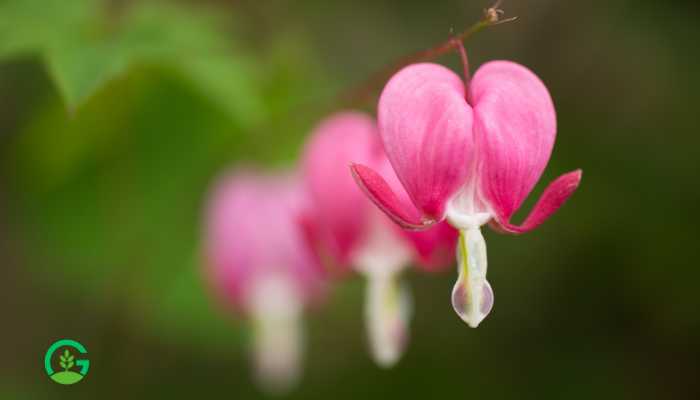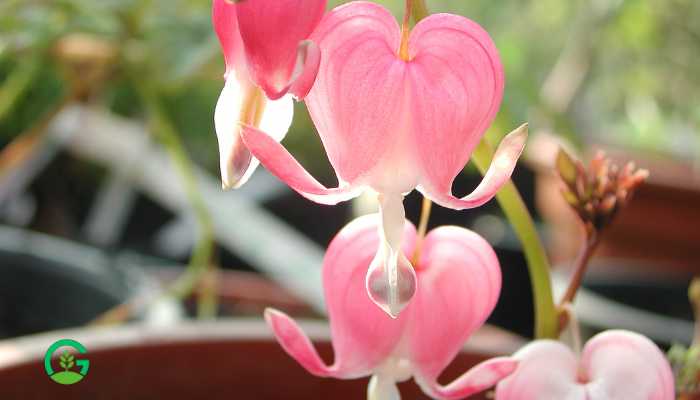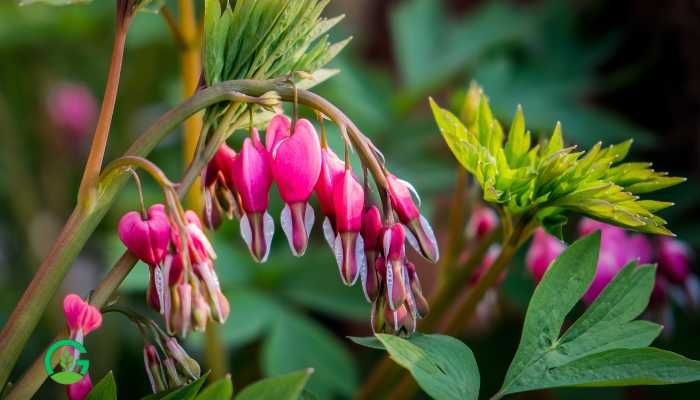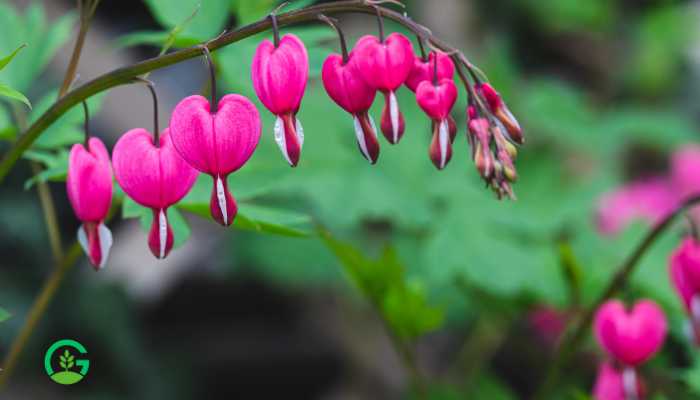Have you ever come across a plant that seems to speak to your soul? The Broken Heart Plant, also known as Dicentra spectabilis or Bleeding Heart, is one such captivating beauty.
Its delicate, heart-shaped flowers evoke emotions and add a touch of whimsy to any garden. Whether you’re an experienced gardener or just starting, learning to grow and care for the Broken Heart Plant can be a rewarding experience.
Let’s dive in and explore how you can nurture this lovely plant to flourish in your garden.
Broken Heart Plant Table of Contents
Introduction to the Broken Heart Plant
The Broken Heart Plant, also known as the Bleeding Heart, is a perennial favorite for many gardeners. Its unique heart-shaped flowers, which appear to “bleed” a drop of nectar, are both enchanting and nostalgic. Native to Asia and North America, this plant thrives in shady, cool environments and is perfect for woodland gardens, shaded borders, or containers.
Why is it called the Broken Heart Plant? Just take a look at its flowers, and you’ll understand. The delicate petals, often in shades of pink and white, hang gracefully from arching stems, resembling tiny hearts dripping with love. This visual metaphor makes it a beloved choice for gardeners looking to add a touch of romance and charm to their outdoor spaces.

Choosing the Right Location
Finding the perfect spot for your Broken Heart Plant is crucial for its health and vitality. These plants prefer partial to full shade, making them ideal for areas where other plants might struggle. Think about the natural habitats where they thrive – shaded forest floors and cool, damp environments.
Key Points:
- Shade: Aim for partial to full shade. Too much sunlight can scorch the delicate leaves.
- Cool Temperatures: They prefer cooler climates, so avoid planting them in areas that get excessively hot.
Consider planting them under large trees, along the north side of buildings, or in shaded garden beds where they can get the protection they need from harsh sunlight.
Preparing the Soil
The right soil can make all the difference when it comes to growing a healthy Broken Heart Plant. These plants thrive in well-drained, rich, and slightly acidic soil. Preparing your garden bed properly can set the stage for a flourishing plant.
Steps to Prepare the Soil:
- Test the Soil: Use a soil testing kit to check the pH level. Aim for a slightly acidic range of 6.0 to 6.5.
- Amend the Soil: Add organic matter such as compost or well-rotted manure to enrich the soil and improve drainage.
- Loosen the Soil: Use a garden fork or tiller to loosen the top 12 inches of soil, ensuring it is not compacted.
By ensuring the soil is well-prepared, you provide the Broken Heart Plant with the ideal conditions to establish strong roots and grow vigorously.

Planting Broken Heart Plant
Planting your Broken Heart Plant correctly is essential for its long-term health and beauty. Whether you’re starting from seeds, transplants, or divisions, here’s a step-by-step guide to get you started.
From Seeds:
- Sow Seeds Indoors: Start seeds indoors 6-8 weeks before the last frost date.
- Transplanting: Once seedlings have at least two sets of true leaves, harden them off by gradually exposing them to outdoor conditions.
From Transplants or Divisions:
- Dig a Hole: Make a hole twice as wide and just as deep as the plant’s root ball.
- Planting Depth: Place the plant in the hole so that the crown is level with the soil surface.
- Backfill and Water: Fill in with soil and water thoroughly to settle the roots.
By following these steps, you’ll give your Broken Heart Plant a strong start in its new home.
Image | Product Name | Review | Price |
Watering Requirements
Watering is a critical aspect of caring for your Broken Heart Plant. These plants need consistent moisture but also require well-drained soil to prevent root rot.
Watering Tips:
- Consistent Moisture: Keep the soil consistently moist, especially during the growing season.
- Mulching: Apply a layer of mulch around the base to retain moisture and keep the roots cool.
- Avoid Overwatering: Ensure the soil is well-drained to prevent waterlogging.
Remember, it’s better to water deeply and less frequently than to give small amounts of water often. This encourages deep root growth and a stronger plant overall.
Fertilizing Your Plant
Feeding your Broken Heart Plant with the right nutrients helps promote lush growth and abundant blooms. While these plants are not heavy feeders, they do benefit from occasional fertilization.
Fertilizing Tips:
- Balanced Fertilizer: Use a balanced, slow-release fertilizer in early spring as new growth begins.
- Organic Options: Consider organic fertilizers like compost tea or fish emulsion for a gentler nutrient boost.
Apply fertilizer according to the package instructions, being careful not to over-fertilize, which can lead to excessive foliage growth at the expense of flowers.
Pruning and Deadheading
Pruning and deadheading your Broken Heart Plant helps keep it looking its best and can encourage more blooms throughout the growing season.
Pruning Tips:
- Remove Dead Stems: Cut back any dead or damaged stems to the base of the plant.
- Deadhead Spent Flowers: Remove spent flowers to encourage new blooms.
- End of Season Pruning: In late fall, cut back the foliage to ground level once it has died back naturally.
Regular pruning keeps the plant tidy and directs its energy towards producing new growth and flowers.
Read More
Dealing with Pests and Diseases
Like any garden plant, the Broken Heart Plant can fall prey to pests and diseases. However, with proper care and attention, you can keep these issues at bay.
Common Pests:
- Aphids: These small insects can be washed off with a strong spray of water or treated with insecticidal soap.
- Slugs and Snails: Use slug pellets or traps to control these common garden pests.
Common Diseases:
- Powdery Mildew: Ensure good air circulation and avoid overhead watering to prevent this fungal disease.
- Root Rot: Avoid waterlogged soil and ensure proper drainage.
By monitoring your plants regularly and taking prompt action, you can prevent most pest and disease problems before they become severe.
Propagating Broken Heart Plant
Propagation is a fantastic way to expand your collection of Broken Heart Plants or share them with friends. The most common methods are division and cuttings.
Division:
- Best Time: Divide the plant in early spring or late fall when it is dormant.
- Dig Up the Plant: Carefully dig up the plant and separate the roots into smaller sections.
- Replant: Plant the divisions in prepared soil and water thoroughly.
Cuttings:
- Take Cuttings: In late spring, take 4-6 inch cuttings from healthy stems.
- Rooting Hormone: Dip the cut end in rooting hormone to encourage root development.
- Plant and Water: Plant the cuttings in a pot with well-draining soil and keep them moist until roots develop.
Propagation can be a rewarding way to create new plants and ensure your garden stays vibrant and full.

Overwintering Your Plant
If you live in a region with cold winters, you’ll need to take steps to protect your Broken Heart Plant during the winter months.
Overwintering Tips:
- Mulch: Apply a thick layer of mulch around the base of the plant to insulate the roots.
- Cut Back Foliage: Cut back dead foliage in late fall to prevent pests and diseases.
- Protect from Frost: If necessary, cover the plant with a frost blanket or burlap to protect it from extreme cold.
By taking these precautions, you can ensure your plant survives the winter and returns with vigor in the spring.
Companion Plants for Broken Heart Plant
Choosing the right companion plants can enhance the beauty and health of your Broken Heart Plant. Look for plants that enjoy similar growing conditions and can complement its delicate flowers.
Great Companions:
- Hostas: Their bold foliage contrasts beautifully with the delicate flowers of the Broken Heart Plant.
- Ferns: Provide a lush, green backdrop that highlights the unique blooms.
- Astilbes: These shade-loving perennials add a splash of color and texture.
Combining these plants can create a harmonious and visually appealing garden bed.
Common Problems and Solutions
Even with the best care, you may encounter some challenges while growing Broken Heart Plants
. Here are a few common problems and how to address them:
Yellowing Leaves:
- Cause: Overwatering or poor drainage.
- Solution: Ensure the soil drains well and adjust your watering schedule.
No Blooms:
- Cause: Insufficient light or improper fertilization.
- Solution: Ensure the plant gets enough indirect light and use a balanced fertilizer.
By identifying issues early and taking corrective action, you can keep your plants healthy and vibrant.

Seasonal Care Tips
Caring for your Broken Heart Plant varies with the seasons. Here are some tips to keep it thriving year-round:
Spring:
- Fertilize: Apply a balanced fertilizer as new growth appears.
- Water: Keep the soil moist as the plant begins to grow.
Summer:
- Water Regularly: Ensure consistent moisture, especially during dry spells.
- Mulch: Apply mulch to retain moisture and keep roots cool.
Fall:
- Prune: Cut back dead stems and foliage.
- Divide: Early fall is a good time to divide and propagate plants.
Winter:
- Protect: Mulch heavily to protect roots from freezing temperatures.
- Water Sparingly: Reduce watering as the plant goes dormant.
By adapting your care routine to the seasons, you can support your plant’s health and growth throughout the year.
Creative Landscaping Ideas
The Broken Heart Plant can be a stunning addition to various garden designs. Here are some creative ideas to incorporate it into your landscape:
- Woodland Garden: Plant it alongside ferns, hostas, and other shade-loving plants to create a serene, forest-like atmosphere.
- Shaded Border: Use it as a focal point in a shaded border, where its delicate flowers can stand out.
- Container Gardens: Grow it in containers on shaded patios or balconies for a touch of romance and charm.
With a little creativity, you can find the perfect spot for this enchanting plant in your garden.
Conclusion and Final Thoughts
Growing and caring for a broken heart plant is a rewarding endeavor that brings beauty and sentiment to any garden. From choosing the right location to seasonal care tips, understanding the needs of this delicate plant ensures that it will thrive and enchant year after year.
Whether you are an experienced gardener or a novice, the broken heart plant can add a touch of romance and whimsy to your outdoor space.
Frequently Asked Questions (FAQs)
Can I grow Broken Heart Plant indoors?
Yes, you can grow the Broken Heart Plant indoors in a well-lit area that receives indirect sunlight. Ensure the pot has good drainage, and maintain consistent moisture in the soil.
How often should I water my Broken Heart Plant?
Water your Broken Heart Plant regularly to keep the soil consistently moist, especially during the growing season. However, avoid waterlogging as it can cause root rot.
When is the best time to divide my Broken Heart Plant?
The best time to divide your Broken Heart Plant is in early spring or late fall when the plant is dormant. This helps minimize stress and encourages successful propagation.
What should I do if my Broken Heart Plant’s leaves turn yellow?
Yellowing leaves can be a sign of overwatering or poor drainage. Check the soil’s drainage and adjust your watering schedule to prevent waterlogged conditions.
Are Broken Heart Plants toxic to pets?
Yes, Broken Heart Plants are toxic to pets if ingested. Keep them out of reach of curious pets and consider planting them in areas not easily accessible to animals.
With these tips and insights, you’re now well-equipped to grow and care for the beautiful Broken Heart Plant. Happy gardening!





















1 thought on “How to Grow and Care for Broken Heart Plant”